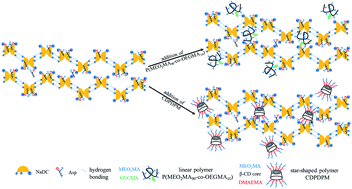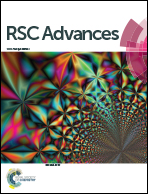Effects of polymers on the properties of hydrogels constructed using sodium deoxycholate and amino acid†
Abstract
The gelation behavior and properties of sodium deoxycholate (NaDC) and L-aspartic acid (Asp) in aqueous solution were investigated in detail at 25 °C. The linear polymer poly(2-(2-methoxyethoxy)ethyl methacrylate-co-oligo-(ethylene glycol) methacrylate) (P(MEO2MA90-co-OEGMA10)) and star-shaped polymer poly(2-(dimethylamino)ethyl methacrylate-b-2-(2-methoxyethoxy)ethyl methacrylate) (CDPDPM) were introduced in NaDC/Asp hydrogels for exploring the effects of polymers on the properties of NaDC/Asp hydrogels and the mechanism underlying gelation processes by polymers was proposed. The hydrogels were characterized by phase behavior observation, polarized optical microscopy (POM), cryogenic scanning electron microscopy (cryo-SEM), X-ray powder diffraction (XRD), Fourier transform infrared (FT-IR) spectroscopy and rheological measurements. Moreover, the adsorption performances of hydrogels with and without polymers to methylene blue (MB) were studied using a UV-vis spectrometer. The results indicated that the transition from sol to gel state was observed with an increase in the Asp concentration in the system. Both linear and star-shaped polymers can participate in the formation of a gel network structure, so that the density of network structure and the mechanical strength of hydrogels increased. Furthermore, it was found that the viscoelasticity of the CDPDPM-containing hydrogel was much higher than that of the P(MEO2MA90-co-OEGMA10)-containing hydrogel under the same condition, indicating that CDPDPM performed better in strengthening the network structure of the hydrogels than P(MEO2MA90-co-OEGMA10) due to the special structure that provided more binding sites for hydrogen bonding and stronger hydrophobicity that inhibited the swelling and dissolution of hydrogels. On coming in contact with the MB solution, the CDPDPM-containing hydrogel can adsorb MB and maintain the hydrogel state for recycling. On the contrary, the NaDC/Asp hydrogel dissolved and P(MEO2MA90-co-OEGMA10)-containing hydrogel collapsed in the MB solution. The properties of the hydrogels are expected to be tailored by introducing polymers with different properties, including the charge numbers, the number of available binding sites, and hydrophobic properties.



 Please wait while we load your content...
Please wait while we load your content...